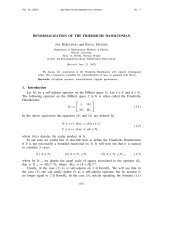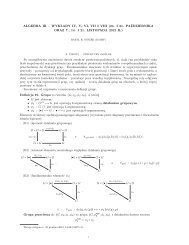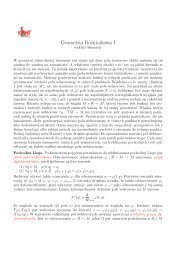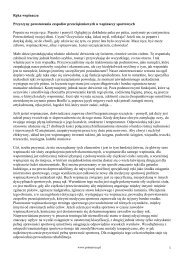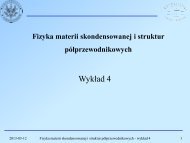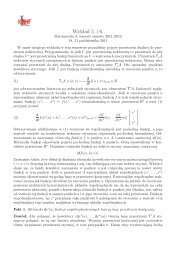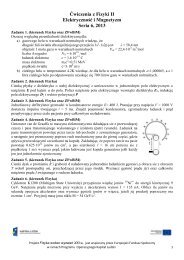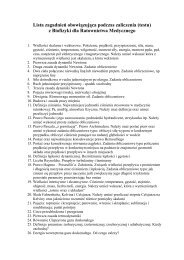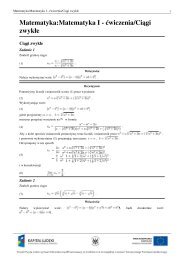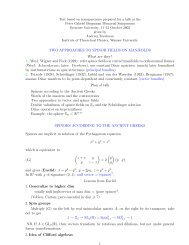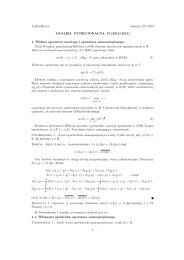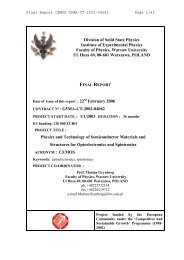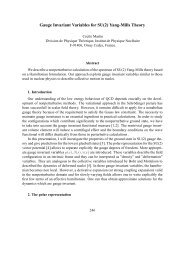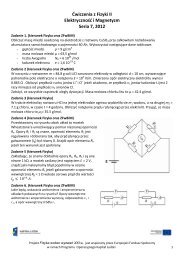Hartmut-Loewen.pdf
Hartmut-Loewen.pdf
Hartmut-Loewen.pdf
You also want an ePaper? Increase the reach of your titles
YUMPU automatically turns print PDFs into web optimized ePapers that Google loves.
3rd Warsaw School of Statictical Physics<br />
Kazimierz Dolny, Poland<br />
<strong>Hartmut</strong> Löwen<br />
Heinrich-Heine Heinrich Heine University Düsseldorf, Düsseldorf Germany<br />
27 June – 3 July 2009
Outline:<br />
1) DDensity it ffunctional ti l theory th of f freezing: f i spheres h<br />
1.1 Phenomenological results<br />
11.2 2 Independent treatment of the different phases<br />
1.3 Unifying Microscopic theories<br />
1.4 Phase diagrams of simple potentials<br />
1.5 Density Functional Theory (DFT)<br />
2) Brownian Dynamics and dynamical density functional theory<br />
2.1 Brownian dynamics (BD)<br />
2.2 Dynamical density functional theory (DDFT)<br />
2.3 Hydrodynamic interactions<br />
3) ) Density y functional theory yfor rod-like particles p<br />
3.1 Statistical mechanics of rod-like particles<br />
3.2 Simple models<br />
3.3 Brownian dynamics of rod-like particles
1) Density functional theory of freezing: spheres<br />
1.1) Phenomenological results:<br />
experiments:<br />
- liquids crystallize into periodic structures at low temperatures or/and<br />
high densities<br />
- translational symmetry is broken<br />
- one of fth the most ti important t tphase h ttransitions iti iin nature t<br />
- when does it happen?
empirical facts:<br />
i) Lindemann-criterion of melting (1910)<br />
root mean square displacement<br />
ltti lattice vectors t Li Lindemann d parameter: t<br />
computer simulation<br />
hard spheres<br />
OCP<br />
Yk Yukawa it interaction ti<br />
criterion: phenomenological rule
ii) Hansen-Verlet rule of freezing (1963)<br />
at freezing, all are similar<br />
criterion:<br />
li liquid id freezes, f if the h first fi maximum i<br />
of exceeds the value 2.85<br />
→ confirmed for Yukawa, OCP,<br />
Lennard-Jones, etc...
1.2) Independent treatment of the different phases<br />
(a) for the solid<br />
impose a prescribed solid with lattice constant .<br />
harmonic lattice theory (phonons)<br />
→ free energy of solid state:<br />
(b) ffor the th li liquid/fluid id/fl id<br />
lattice sum of potential energy per particle.<br />
liquid theory (e.g. HNC closure).<br />
→ free energy of the liquid state.
Maxwell-double tangent construction<br />
( (ensures equality li of fpressure and d chemical h i lpotentials i l in i the h different diff phases) h )<br />
→ phase diagram (typically 1st order freezing)
1.3) Unifying Microscopic theories<br />
i) ) density yfunctional theory y( (in 3d) )<br />
based on liquid<br />
solid lid ≡ condensation d ti of f liquid li id density d it modes d<br />
ii) crystal-based theory (in 2d) (Kosterlitz-Thouless)<br />
defects in solid<br />
liquid ≡ solid with an accumulation of defects
1.4) Phase diagrams of simple potentials<br />
(known from computer simulations + theory)<br />
a) hard spheres<br />
iinternal l energy<br />
averaged potential energy<br />
there is only yentropy, py,ppacking geffects
phase diagram<br />
above freezing: state with higher entropy (solid), has higher order
) plasma (with neutralizing background)<br />
only the combination determines correlations, phase diagram, etc.<br />
coupling parameter<br />
c) soft spheres<br />
phase diagram<br />
freezing into fcc lattice<br />
freezing g<br />
into bcc lattice
d) Yukawa-system<br />
only 2 reduced parameters:
e) Lennard-Jones-system<br />
phase p diagram: g<br />
2 reduced parameters:
f) sticky hard spheres<br />
iis needed d dto get a li liquid id<br />
is needed to get an isostructural<br />
solid-solid<br />
transition<br />
phase diagram:
g) ultrasoft interactions<br />
repulsive, realized for star polymers<br />
exhibit hibit “ “exotic“ ti “ stable t bl solid lid lattices l tti lik like bco, b sc, A15, A15 diamond, di d etc. t<br />
PRL 80, 4450 (1998)
1.5) Density Functional Theory (DFT)<br />
SSee also: l Lectures L t of fB Bob b Evans E<br />
a) Basics<br />
Basic variational principle:<br />
There exists a unique grand-canonical grand canonical free energy energy-density-functional<br />
density functional ,<br />
which gets minimal for the equilibrium density<br />
and then coincides with the real grandcanoncial g free energy. gy<br />
→ is also valid for systems which are inhomogeneous on a microscopic scale.<br />
In principle, principle all fluctuations are included in an external potential which breaks all<br />
symmetries.<br />
For interacting gsystems, y , in 3d, ,<br />
is not known.
exceptions:<br />
i) ) soft potentials p in the high g density y limit, , ideal gas g (how ( density y limit) )<br />
ii) 1d: hard rod fluid, exact Percus functional<br />
strategy:<br />
1) chose an approximation<br />
2) parametrize the density field with variational parameters gas, liquid:<br />
solid:<br />
with lattice vectors of bcc or fcc or ... crystals, spacing sets , vacancies?<br />
variational parameter<br />
Gaussian approximation for the solid density orbital is an excellent approximation<br />
3) ) minimize with respect p to all variational parameters p<br />
� bulk phase diagram EPL 22, 245 (1993)<br />
ρρ
example:<br />
solid/liquid coexistence<br />
coexistence it implies:<br />
i li
contour plot of
) approximations for the density functional<br />
1) ideal gas, gas<br />
since<br />
„generalized barometric law“<br />
Thi This is i indeed i d dthe h equilibrium ilib i density d i of fan inhomogeneous i h<br />
gas.<br />
2) in the interacting case,<br />
defines the excess free energy functional
approximations on different levels<br />
1) LDA LDA, llocal l density d i approximation: i i<br />
where is the excess free energy density in a homogeneous (bulk)<br />
system, input, valid only for small inhomogeneites<br />
2) LDA + mean field:<br />
with<br />
� homogeneous limit is respected valid for ”moderate“ inhomogeneites, but not<br />
for density variations on the microscopic scale
(DH approx.)
3) Ramakrishnan-Youssuf (RY) 1979<br />
is reproducing the direct correlation function<br />
exactly at<br />
results l in i a solid-fluid lid fl id transition i i (f (for hard h d spheres)<br />
h )
4) Weighted density approximation (WDA) Curtin & Ashcroft, 1985<br />
free energy per particle; weighted density<br />
determine such that<br />
for all<br />
WDA yields excellent data for hard sphere freezing, etc. problem with<br />
WDA WDA: overlapping l i hard h d sphere h configurations fi ti are not t excluded<br />
l d d
5) Rosenfeld functional (for hard spheres)<br />
(fundamental measure theory (FMT))<br />
with<br />
geometrical measures
6 weight functions:<br />
hard sphere diameter<br />
and<br />
ffunctional ti lsurvives i dimensional di i lcrossover 3D 3D→2D→1D→0D<br />
2D 1D 0D<br />
PRE 55, 4245 (1997)
advantages<br />
- excludes overlapping hard sphere configurations<br />
- yields as output<br />
- excellent data for hard sphere freezing<br />
results results, hard spheres
6) Hard sphere pertubation theory<br />
then<br />
approximate<br />
good phase diagram for Lennard-Jones (LJ)<br />
by a hard sphere<br />
potential t ti l with ith an effective ff ti diameter di t<br />
(Barker, Henderson)
2) Brownian Dynamics and dynamical density<br />
ffunctional ti lth theory<br />
2.1) Brownian dynamics (BD)<br />
literature: M.Doi, , S.F. Edwards, , “Theory yof Polymer y Dynamics“, y , Oxford, , 1986<br />
colloidal particles will be randomly kicked by the solvent<br />
Smoluchowski picture<br />
Brownian motion is diffusion. time-dependent density field of the particle(s)
Fick´s law<br />
current density<br />
example:<br />
phenomenological diffusion coefficient<br />
mass conservation → continuity equation<br />
→ combined with Fick´s law:<br />
diffusion equation
Thi This is i valid lid for f ffree particles ti l with ith a given i intial i ti l density d it<br />
With an external potential , there is the force<br />
acting on the particles<br />
→ drift velocity of the particles resp. an additional current density<br />
assumption: totally overdamped motion<br />
friction coefficient<br />
remark: for a sphere (radius R) in a viscous solvent, solvent Stokes equation yields:<br />
shear viscosity
total current density<br />
in equilibrium:<br />
i)<br />
ii) the total current has to vanish, i.e.:<br />
→<br />
hence<br />
→ continuity equation<br />
St Stokes-Einstein-relation<br />
k Ei t i lti<br />
(special case for fluctuation-dissipation-theorem)
Smoluchowski equation<br />
Diffusion in phase space<br />
→ non-interacting particles<br />
→ normalized:<br />
→<br />
→<br />
is probality to find a particle at position and time<br />
is identical to<br />
except normalization:<br />
Smoluchowski-equation (Focker-Planck-equation)
now: N interacting particles<br />
more compact notation: (analogue for all other vectors)<br />
velocity of particle induces<br />
flow of solvent<br />
→ (force) ( ) / movement of other pparticle<br />
→ hhydrodynamic d d i iinteraction t ti
linear relation between and<br />
One can show:<br />
positive definite<br />
mobility matrix,<br />
calculated from<br />
Navier-Stokes-eq. q<br />
probability density for interacting particles with equation:<br />
with<br />
→ generalized Smoluchowski equation for interacting particles
One can write:<br />
often:<br />
Smoluchowski operator (compare Liouville operator)<br />
(no hydrodynamic interactions,<br />
good for low packing fractions )
Langevin-picture<br />
Smoluchowski-picture: with diffusion dynamics<br />
Langevin-picture: stochastic trajectories in real-space<br />
assume: system overdamped<br />
probability distribution for<br />
First, we consider only one particle<br />
in an external potential<br />
with random force<br />
→ stochastic differential equation:<br />
comes from random kicks of the<br />
solvent
observable strategy<br />
1) solve (�) for a given 2) average with<br />
Now: is Gaussian distributed<br />
(i (in principal i i l functional f ti l integral) i t l)<br />
Equivalence of Langevin and Smoluchowski picture for<br />
Equivalence of Langevin and Smoluchowski picture for<br />
interacting particles (no hydrodynamic interactions)
with hydrodynamic interactions(HI.):<br />
depends on<br />
The Smoluchowski equation (��) is obtained from the<br />
following Langevin equations:
2.2) Dynamical density functional theory (DDFT)<br />
1) Derivation from the Smoluchowski equation<br />
no HI.<br />
(Archer, Evans, J.Chem.Phys. 121, 4246 (2004))<br />
recall Smoluchowski equation for the N-particle density<br />
idea: integrate out degrees of freedom
integration yields<br />
2-particle density:<br />
integrating the Smol Smoluchowski cho ski equation eq ation with<br />
ith
1)<br />
now:
3)<br />
in equilibrium, necessarily
i.e.<br />
(Yvon (Yvon, Born Born, Green hierarchy YBG)
in equilibrium, DFT says:<br />
apply<br />
combined with YBG:<br />
We postulate that this argument holds also in nonequilibrium. In doing so, nonequilibrium<br />
correlations are approximated by equilibrium ones at the same<br />
(via a suitable in equilibrium)
hence:<br />
applications:<br />
DDFT<br />
– time-dependent external potentials<br />
DDFT makes very good approximations for the dynamical density fields.<br />
eeven en for free freezing, ing glass transitions transitions, crystal cr stal growth gro th when hen tested against<br />
BD computer simulations<br />
example: dynamics of freezing, crystal growth
colloidal particles<br />
colloidal dispersions<br />
(from A. Imhof and D. Pine)
Equilibrium<br />
Non-equilibrium<br />
& in colloidal dispersions p<br />
excellent model<br />
systems<br />
phase transformation Kinetics<br />
(crystallization, glass transition,<br />
hhomogeneous and d heterogeneous<br />
h<br />
nucleation)<br />
plus p an external field ( (shear, ,ggravity, y, electric, , laser-optical, p , walls etc.) )<br />
SPP 1296 Heterogene Keim- und Mikrostrukturbildung:<br />
Schritte zu einem system- y<br />
und skalenübergreifenden Verständnis<br />
(coordinator: H. Emmerich)<br />
German German-Dutch Dutch network SFB TR6
The road map of complexity<br />
H. Löwen, Journal of Physics: Condensed Matter 13, R415 (2001)
Colloids - controlled by an external magnetic field<br />
• spherical colloids confined<br />
to water/air interface<br />
• superparamagnetic ti due d to t<br />
Fe2O3 doping<br />
• external magnetic field B v<br />
• external magnetic field B<br />
� induced dipole<br />
moments<br />
v v<br />
� tunable interparticle m χB<br />
potential<br />
tilt angle φφ<br />
surface normal B v<br />
n v<br />
φ =<br />
0<br />
φ =<br />
0<br />
54.<br />
7<br />
φ =<br />
0<br />
90<br />
= repulsive no interaction attractive<br />
potential ( for θθ<br />
= 0 )<br />
r<br />
u( r ) = uHS<br />
m<br />
+<br />
2<br />
2<br />
1<br />
r<br />
3<br />
( 1<br />
2 2<br />
− 3cos<br />
φ cos θ )<br />
θ = ( r, B )<br />
v v
particle p configurations g for different fields<br />
�<br />
B perp. perp to surface, surface crystal<br />
(P. Keim, G. Maret et al)<br />
� B perp. to surface, liquid<br />
in-plane B<br />
��
Crystal growth at externally imposed nucleation clusters<br />
Idea: impose a cluster of fixed colloidal particles<br />
(e.g. by optical tweezer)<br />
Does this cluster act as a nucleation seed for further crystal<br />
growth?<br />
cf: homogeneous nucleation: the cluster occurs by thermal<br />
fl fluctuations, t ti here h we prescribe ib them th<br />
How does nucleation depend p on cluster size and shape? p<br />
(S (S. van Teeffelen Teeffelen, C.N. C N Likos, Likos H. H Löwen, Löwen PRL, PRL 100,108302 100 108302 (2008))
DDFT, , equilibrium q functional byy Ramakrishnan-Yussouff<br />
(S (S. van Teeffelen et al, al EPL 75 75, 583 (2006); J. J Phys.: Phys : Condensed Matter Matter, 20 20, 404217 (2008))<br />
2d V(r)<br />
u 0<br />
3<br />
coupling parameter<br />
= (magnetic colloids with dipole moments)<br />
equilibrium q freezing gfor<br />
r<br />
Γ = u ρ /k T<br />
Γ =Γ =<br />
3/2<br />
0 B<br />
f<br />
36
imposed nucleation seed<br />
cut-out of a rhombic crystal with N=19 particles<br />
A<br />
φ<br />
t0: undercooled liquid
imposed nucleation seed<br />
cut-out of a rhombic crystal with N=19 particles<br />
A<br />
φ<br />
t0: undercooled liquid
nucleation + growth<br />
0<br />
φ= 60<br />
Aρ =<br />
0.7
no nucleation<br />
0<br />
φ= 60<br />
Aρ =<br />
0.6
„island“ for heterogeneous nucleation in (cosφ,A ρ)<br />
space.<br />
strongly asymmetric in A<br />
symmetric ti in i φ<br />
Brownian dynamics<br />
computer simulation
Two stage process:<br />
- sub-Brownian time: relaxation to “ideal“ crystal positions<br />
- Brownian time: crystal growth<br />
x () t<br />
Time evolution of the position of the linear array‘s three rows of crystalline particles i and the position of the<br />
crystal front x () t as a function of time.<br />
f<br />
Dynamical density functional theory results are compared against Brownian dynamics simulation data. data<br />
The arrows indicate the typical time scales on which the relaxation is occurring and on which the crystal growth sets<br />
in, respectively.
Two linear arrays separated by an empty core<br />
• Snapshots of the central region of the dimensionless density field<br />
ρ(,)/ rt ρ of a linear hollow nucleus of two times three infinite rows of hexagonally<br />
crystalline y p particles at times t / r B<br />
= 0, 0.01, 0.1, 0.63, 1.0 (from ( top p to bottom). )<br />
Note that the images display twice the system‘s central region of dimensions<br />
L x L<br />
for better visiblity.<br />
/4 2<br />
x y
2.3) Hydrodynamic interactions<br />
How does look like explicitely?<br />
Solve Stokes/Navier-Stokes Stokes/Navier Stokes equations, difficult problems:<br />
1) is long-ranged<br />
H.I are important for volume fractions<br />
2) H.I. have many-body character, pair expansion only possible at low concentrations<br />
3) H.I. have quite different near-field behaviour. They are divergent, lubrication
standard approximations:<br />
each quantity is a 3 × 3 matrix<br />
0) no H.I.<br />
1) Oseen-Tensor<br />
with ihO Oseen tensor<br />
dyadic product or tensor product<br />
far field term, , long granged g of H.I.<br />
hydrodynamic radius<br />
shear viscosity of solvent
2) Rotne-Prager-tensor<br />
with<br />
3) higher higher-order order expansions<br />
4) tilt triplet contributions tibti (Beenaker, (B k Mazur)<br />
M )
DDFT for hydrodynamic y y interactions<br />
(M. Rex, H. Löwen, Phys. Rev. Letters 101, 148302 (2008))<br />
starting point: Smoluchowski equation total potential energy<br />
two particle<br />
approximation:<br />
configuration configuration-dependent dependent mobility tensor which<br />
describes hydrodynamic interactions
Rotne-Prager expression<br />
( r ) = 0<br />
v<br />
ω v 3 σ H vˆ<br />
vˆ<br />
1 σ H 3 v<br />
( ) ( 1 ) ( ) ( 1 3ˆ<br />
vˆ<br />
σ H 7<br />
ω = + ⊗ + − ⊗ ) + 0((<br />
) )<br />
11<br />
12<br />
r<br />
8<br />
r<br />
r<br />
r<br />
Integrating Smoluchowski equation (Archer, Evans, 2004)<br />
16<br />
r<br />
r<br />
r<br />
r
Possible closure<br />
easier:<br />
with<br />
− β<br />
suitably averaged density
Application:<br />
colloids in an oscillating trap<br />
R 1 = 4σ , R 2 = σ<br />
V = 10k<br />
T , V = k<br />
1<br />
B<br />
2<br />
τ = 0.<br />
5τ<br />
, τ = σ /<br />
(H) (N)<br />
hard spheres with interaction diameter σσ<br />
=<br />
σσ<br />
H<br />
4<br />
3<br />
B<br />
B<br />
2<br />
B<br />
T<br />
D<br />
0
the breathing mode<br />
green/red: / d (N) blue/purple: (H)
stroboscopic view<br />
t i /t B = 2.5, 2.6, 2.7, 2.75, 2.85, 2.9, 3.0<br />
i = 0 1 2 3 4 5 6<br />
with<br />
HI<br />
(H)<br />
without<br />
HI<br />
(N)<br />
good agreement between simulation (red) and DDFT (black)
central<br />
ddensity it<br />
second<br />
moment<br />
(D) curve D (φ)<br />
relaxation to the steady state<br />
o<br />
C. P. Royall et al, PRL 98, 188304 (2007))
3) Density functional theory for rod-like particles<br />
3.1) Statistical mechanics of rod-like particles<br />
(1) molecular dipolar fluids<br />
(2) rod-like colloids<br />
(3) molecular fluids without dipole moment (apolar), (apolar) e.g. e g molecule<br />
(4) plate-like objects (clays)<br />
now: additional orientational degree of freedom
partition function:<br />
with:<br />
while is the inertia tensor and the unit-sphere in 3d.<br />
central quantity:<br />
central quantity:<br />
one-particle density
density of center-of-masses:<br />
orientational order:
pair correlation function:<br />
Different phases are conceivable:<br />
(1) fluid (disordered) phase isotropic phase<br />
(1) fluid (disordered) phase, isotropic phase<br />
center-of-mass-positions and orientations are disordered
(2) nematic phase<br />
positions iti are disordered di d d and d orientations i t ti are ordered d d<br />
nematic director
nematic order parameter<br />
3x3 tensor:<br />
with:
three eigenvalues with<br />
largest eigenvalue:<br />
nematic director: corresponding eigenvector<br />
perfect orientation: for all nematic director<br />
→ if the h two lower l eigenvalues i l are identical, id i l uniaxial i i lnematics i<br />
→ if biaxial nematics<br />
→ in isotropic phase:<br />
experimental p effect: birefringence g
(3) smectic A phase<br />
position ordered along orientation ordered<br />
(4) smectic B phase<br />
as smectic A phase but in plane triangular lattice
(5) columnar phase:<br />
(6) plastic crystal:<br />
positions ordered,<br />
positions ordered,<br />
orientations disordered
(7) full crystalline phases<br />
further more „exotic“ phases:<br />
positions and orientations ordered
3.2) Simple models<br />
hard objects<br />
A) Analytical results by Onsager, 1948<br />
consider limit<br />
virial expansion up to 2 order gets exact result:<br />
there is an isotrop-nematic transition, first order (with density jump)<br />
at coexistence<br />
correlations to finite<br />
irrelevant only for
B) Computer simulations<br />
phase diagram of hard<br />
spherocylinders<br />
hard ellipsoids p
C) Density functional theory<br />
There exists a unique grandcanonical free energy functional<br />
(functional of the one-particle density) which becomes minimal for the equilibrium<br />
density and equals then the real grand canonical free energy
for spherocylinders:<br />
1) SMA (smoothed density approximations) R. Holyst et al, 1988<br />
→ yields several stable liquid crystalline phases<br />
(isotropic, ( p nematic, smectic A, crystalline) y )<br />
2) MWDA (H. Graf, 1999)<br />
→ iimproved d results l with i h plastic, l i AAA phase h<br />
3) extension of Rosenfeld theory (K (K.Mecke Mecke and HH.Hansen-Goos) Hansen Goos)<br />
other interaction (beyond hard body)<br />
perturbation theory within mean-field approach
3.3) Brownian dynamics of rod-like particles<br />
start from Smoluchowski picture ωˆ<br />
full probability density distribution<br />
Smoluchowski equation:<br />
(Textbook J.K.G. Dhont)<br />
∂<br />
∂t<br />
P = L Lˆ<br />
ûu ≡ ω<br />
v v<br />
r ,..., ; ˆ ,..., ˆ<br />
1 rN<br />
ω ω , t)<br />
123<br />
142<br />
243<br />
P( 1 N<br />
S<br />
P<br />
2<br />
v N<br />
N<br />
r ˆ ω<br />
total potential energy<br />
Smoluchowski operator ∑<br />
= ⎩ ⎨⎧<br />
N v t ⎡ v 1 v N N ⎤<br />
Lˆ v<br />
= ∇ v<br />
s<br />
r • D(<br />
ˆ ωi<br />
) • ⎢∇<br />
v<br />
r + ∇ v<br />
rU<br />
( r , ˆ ω , t)<br />
i<br />
i<br />
i<br />
⎥<br />
i 1<br />
⎣ kBT<br />
⎦<br />
r<br />
ˆ ˆ ∇<br />
Ri = ωi × ˆ ω<br />
⎡<br />
⎤<br />
+ ˆ • ˆ 1<br />
⎢ + ˆ v N N<br />
D<br />
( , ˆ<br />
rRi<br />
Ri<br />
RiU<br />
r ω , t)<br />
⎥<br />
⎣ kBT<br />
⎦<br />
i<br />
D( ˆ ω ) ˆ ˆ ( 1 ˆ ˆ<br />
i = D ωi<br />
⊗ ωi<br />
+ D − ωi<br />
⊗ ωi<br />
)<br />
t<br />
ll<br />
⊥ t
idea of Archer and Evans JCP 121, 4246 (2004)<br />
integrate Smoluchowski equation<br />
N dr dr d ˆ ω ... d ˆ ω<br />
... 2<br />
∫ 2 ∫ N ∫ ∫ N<br />
v<br />
v v<br />
∂ρρ ( r , ˆ ω , t ) v t ⎡ v v 1 v v v F ( r , ˆ ω , t ) ⎤<br />
= ∇ v • D(<br />
ˆ)<br />
• ⎢ ∇ ( ˆ t)<br />
+ ( ˆ t)<br />
∇ V ( ˆ<br />
r D(<br />
ω)<br />
v<br />
r ρ(<br />
r,<br />
ω,<br />
t)<br />
ρ(<br />
r,<br />
ω,<br />
t)<br />
v<br />
rVext<br />
( r,<br />
ω,<br />
t ) − ⎥<br />
∂t ⎣<br />
kBT<br />
kBT<br />
⎦<br />
⎡<br />
⎤<br />
+ ˆ • ˆ v 1 v<br />
v 1 v v<br />
D ⎢ ( , , ) + ( , ˆ,<br />
) ∇ ( , ˆ,<br />
) − T ( r,<br />
ˆ<br />
rR<br />
Rρ<br />
r ω t ρ r ω t v<br />
⎢<br />
rVext<br />
r ω t<br />
ω,<br />
t)<br />
⎥<br />
⎣<br />
k kB T<br />
k kB<br />
T ⎦<br />
with average force and torque<br />
v r<br />
F(<br />
r,<br />
ˆ ω,<br />
t)<br />
v v<br />
T ( r,<br />
ˆ ω,<br />
t)<br />
=<br />
3<br />
= −∫dr′<br />
∫<br />
−<br />
2<br />
d ω′<br />
ρ<br />
( 2)<br />
v v v v v v v v v<br />
( r,<br />
r′<br />
, ˆ ω,<br />
ˆ ω′<br />
, t)<br />
∇ vV ( r,<br />
r′<br />
, ω,<br />
ω′<br />
, t)<br />
= ρ ( r,<br />
ˆ ω)<br />
∇<br />
v v<br />
( r,<br />
r′<br />
, ˆ ω,<br />
ˆ ω′<br />
, t)<br />
Rˆ<br />
[ ρ]<br />
δFexc<br />
δρ ( r,<br />
ˆ ω)<br />
r 2<br />
0<br />
v<br />
r v<br />
0<br />
v v v v<br />
( r,<br />
r′<br />
, ω,<br />
ω′<br />
, t)<br />
[ ρ]<br />
v ˆ δFexc<br />
ρ ( , ˆ 0 r ω)<br />
R<br />
δρ ( r,<br />
ˆ ω)<br />
3 2 ( 2)<br />
∫dr′ ∫ d ω′<br />
ρ<br />
v<br />
rV2 =<br />
v<br />
0<br />
in general unknown<br />
in equilibrium (Gubbins CPL 76, 329 (1980))
“adiabatic“ approximation: assume the pair correlations in<br />
nonequilibrium are the same as those for an equilibrium system with<br />
v<br />
the same one-body density profile (established by a suitable V ˆ ext (r, ω,t))<br />
v<br />
∂ρ(<br />
r,<br />
ˆ ω,<br />
t)<br />
v t<br />
v<br />
⎡ v v δF<br />
= ∇ v • D(<br />
ˆ)<br />
• ⎢ ( r,<br />
ˆ<br />
r ω ρ ω,<br />
t)<br />
∇ v<br />
r<br />
∂ t<br />
⎢<br />
⎣<br />
δδρ<br />
( r,<br />
ˆ ω,<br />
t )<br />
v<br />
⎡<br />
[ ] ⎤<br />
+ ˆ v ˆ δF<br />
ρ(<br />
r,<br />
ˆ ω,<br />
t)<br />
D ⎢ ( , ˆ<br />
r rR⎢<br />
ρρ ( r,<br />
ω , t ) R v ⎥⎦<br />
⎣<br />
δ ( ˆ )<br />
⎥<br />
⎣<br />
δρ(<br />
r,<br />
ˆ ω,<br />
t)<br />
⎦<br />
[ ρ(<br />
r,<br />
ˆ ω,<br />
t)<br />
] ⎤<br />
v ⎥⎦<br />
⎥<br />
⎦<br />
DDFT<br />
with the equilibrium Helmholtz free energy density functional<br />
v<br />
v<br />
3 v v<br />
[ ( ) ] [ ] d r d ˆ ωρ(<br />
r,<br />
ˆ ω)<br />
V ( r,<br />
ˆ ω,<br />
t)<br />
3<br />
3<br />
[ ρ]<br />
= k T d r d ˆ ( r,<br />
ˆ ) ln ( r,<br />
ˆ<br />
B ∫ ∫ ωρ<br />
ω Λ ρ ω)<br />
− 1 + Fext<br />
ρ + ∫<br />
F ext<br />
(M. Rex, H.H. Wensink, H.L., PRE 76, 021403 (2007))<br />
∫
approximation for the density functional<br />
mean mean-field field<br />
F exc<br />
1<br />
v v v<br />
= ω )<br />
2<br />
3 3<br />
[ ρ] ∫ d r ∫ d r′<br />
∫ d ˆ ω ∫ dω′<br />
ρ(<br />
r,<br />
ˆ ω′<br />
) v ( , ′ , ˆ,<br />
ˆ′<br />
2 r r ω<br />
(caveat: ( brings g ideal rotational dynamics) y )<br />
time t e independent depe de t
Model<br />
Gaussian segment-segment segment segment interaction<br />
K K<br />
v v<br />
v ( , , ˆ , ˆ<br />
2 r i i, r i i,<br />
ωω<br />
i i,<br />
ωω<br />
i ) = εε<br />
∑ ∑ exp( −<br />
V ext<br />
αβ<br />
( 2<br />
α= −K<br />
β= −K<br />
σ<br />
Δ<br />
L<br />
v<br />
( r,<br />
ˆ ω,<br />
t)<br />
=<br />
∑ ∑<br />
V<br />
0<br />
Z<br />
( )<br />
Z(<br />
t)<br />
Z<br />
V0<br />
( )<br />
Z(<br />
t)<br />
10<br />
10<br />
N s<br />
r<br />
2<br />
)<br />
= 3L<br />
= σ<br />
confining slit<br />
Δ<br />
=<br />
L<br />
N s − 1<br />
V B<br />
0 = 10k T = Φ<br />
2<br />
0 cos − Φ ϑ aligning field<br />
0
Z<br />
ϑ<br />
z<br />
ω<br />
V nem
full density<br />
orientationally<br />
averaged g<br />
density<br />
orientational<br />
ordering<br />
second moment<br />
Results<br />
ρ(<br />
z, ϑ,<br />
t)<br />
π / 2<br />
∫<br />
ρ( z,<br />
t)<br />
= dϑ<br />
sin ϑρ(<br />
z,<br />
ϑ,<br />
t)<br />
0<br />
π / 2<br />
1<br />
⎡3<br />
2 1⎤<br />
S( z,<br />
t)<br />
= dϑ<br />
sin ϑ cos ϑ ρ(<br />
z,<br />
ϑ,<br />
t)<br />
ρ(<br />
z,<br />
t)<br />
∫ ⎢<br />
−<br />
ρ( , ) 0 ⎣2<br />
2⎥<br />
0 ⎣<br />
⎦<br />
∑ ∞<br />
∑<br />
−∞<br />
2<br />
m ( t)<br />
= dzz ( ρ(<br />
z,<br />
t)<br />
− ρ(<br />
z,<br />
t = ∞))<br />
2
slow compression (set-up A) full density<br />
ρ(z, ϑ,t)
σ 3 ρ(z)<br />
10<br />
8<br />
set-up A DDFT (solid curves) and BD (dashed curves)<br />
12 (a)<br />
6<br />
4<br />
2<br />
0<br />
t<br />
0<br />
t 1<br />
t 2<br />
t<br />
3<br />
t 4<br />
t<br />
5<br />
t<br />
6<br />
-2 -1.5 -1 -0.5 0 0.5 1 1.5 2<br />
z/σ<br />
σ 3 S(z)<br />
0.5<br />
0.4<br />
0.3<br />
0.2<br />
0.1<br />
0<br />
-0.1<br />
-0.2<br />
-0.3<br />
-0.4<br />
-0.5<br />
t<br />
0<br />
t 1<br />
t 2<br />
t 3<br />
t<br />
4<br />
t<br />
5<br />
t<br />
6<br />
(b)<br />
-2 -1.5 -1 -0.5 0 0.5 1 1.5 2<br />
t0 = 0.0 t1 = 0.2 τ B, t 2 = 0.4 τ B, t3 = 0.6 τ B, t4 = 0.8 τ B, t5 = 0.9 τ B, t6 = 15.0τB<br />
z/σ
σ z)<br />
3 ρ(z)<br />
set-up B DDFT (solid curves) and BD (dashed curves)<br />
12<br />
(a)<br />
10<br />
8<br />
6<br />
4<br />
2<br />
0<br />
t<br />
6<br />
5<br />
t t 4<br />
t<br />
3<br />
t 2<br />
t 1<br />
t<br />
0<br />
-2 -1.5 -1 -0.5 0 0.5 1 1.5 2<br />
z/σ<br />
σ )<br />
3 S(z)<br />
0.5<br />
0.4<br />
0.3<br />
0.2<br />
0.1<br />
0<br />
-0.1<br />
-0.2<br />
-0.3<br />
-0.4<br />
-0.5<br />
t<br />
6<br />
t 1<br />
t<br />
0<br />
t<br />
5<br />
t 4<br />
t 3<br />
t 2<br />
(b)<br />
-2 -1.5 -1 -0.5 0 0.5 1 1.5 2<br />
t0 = 0.0 t1 = 0.2 τ B, t 2 = 0.4 τ B, t3 = 0.6 τ B, t4 = 0.8 τ B, t5 = 0.9 τ B, t6 = 15.0τB<br />
z/σ
expansion compression<br />
transient parallel order transient homeotropic order
σ )<br />
3 ρ(z)<br />
set-up C DDFT (solid curves) and BD (dashed curves)<br />
12<br />
t<br />
0<br />
(a)<br />
0.5<br />
0.4<br />
10<br />
0.3<br />
0.2<br />
8<br />
t<br />
1<br />
0.1<br />
6<br />
4<br />
t<br />
6<br />
t<br />
5<br />
t<br />
4<br />
t<br />
3<br />
t<br />
2<br />
0<br />
-0.1<br />
-0.2<br />
2<br />
-0.3<br />
-0.4<br />
0<br />
-2 -1.5 -1 -0.5 0 0.5 1 1.5 2<br />
-0.5<br />
z/σ<br />
σ )<br />
3 S(z)<br />
t<br />
6<br />
t<br />
5<br />
t 4<br />
t<br />
0<br />
t<br />
1<br />
t<br />
2<br />
t<br />
3<br />
(b)<br />
-2 -1.5 -1 -0.5 0 0.5 1 1.5 2<br />
t0 = 0.0 t1 = 0.02 τ B, t 2 = 0.04 τ B, t3 = 0.06 τ B, t4 = 0.08 τ B, t5 = 0.25 τ B, t6 = 15.0τB<br />
z/σ
mm (t) (<br />
2<br />
7.5<br />
5<br />
2.5<br />
0<br />
-2.5<br />
-5<br />
m 2 (t)<br />
0.2<br />
0.1<br />
0<br />
-0.1<br />
-0.2<br />
0 5 t/τ<br />
B 10<br />
-7.5<br />
0 0.5 1<br />
t/τ<br />
B<br />
1.5 2<br />
short-dashed: slow compression (set-up A)<br />
llong-dashed: d h d slow l expansion i (set-up ( t B)<br />
full curve: instantaneous expansion (set-up C)
Conclusions<br />
- generalization of DDFT towards anisotropic colloidal<br />
particles<br />
- good agreement with BD simulation for nontrivial<br />
relaxation problems<br />
future:<br />
• more realistic density functionals (FMT) as proposed by<br />
Mecke and Hansen-Goos.<br />
work by A. Härtel, HL.
From „passive“ to „active“ particles<br />
inert particle<br />
in an external field<br />
Self-propelled particles with an<br />
external motor<br />
- bacteria (E. ( coli) ) - sperm p<br />
- colloidal microswimmers („micromotors“)<br />
GENUINE NONEQUILIBRIUM
COLLOIDAL MICROSWIMMERS<br />
anisotropic (capped)<br />
colloidal ll id l particles ti l<br />
suspended in water<br />
+<br />
H<br />
2O2 O<br />
trajectories<br />
Brownian motion is<br />
relevant<br />
arXiv: 0807.1619, L. Baraban, P. Leiderer, A. Erbe et al<br />
catalytic chemical<br />
reaction at the<br />
surface<br />
⇒ drive<br />
plus external<br />
magnetic field
L. Baraban, private communication<br />
mixture of active“ and passive“ particles in confining geometry<br />
mixture of „active and „passive particles in confining geometry<br />
wall aggregation?
) Collective behaviour (no torque)<br />
Self-propelled Self propelled Brownian rods in a confining channel<br />
F = 1 KBT / L<br />
F = 5 KBT / L<br />
F KT L<br />
0<br />
0<br />
-aggregation gg g near system y walls<br />
- transient hedgehog clusters<br />
- iin line li with i ha microscopic i i<br />
dynamical density functional theory<br />
= 10 B / 0<br />
H. H. Wensink, HL, Phys. Rev. E. 78,<br />
031409 (2008)



